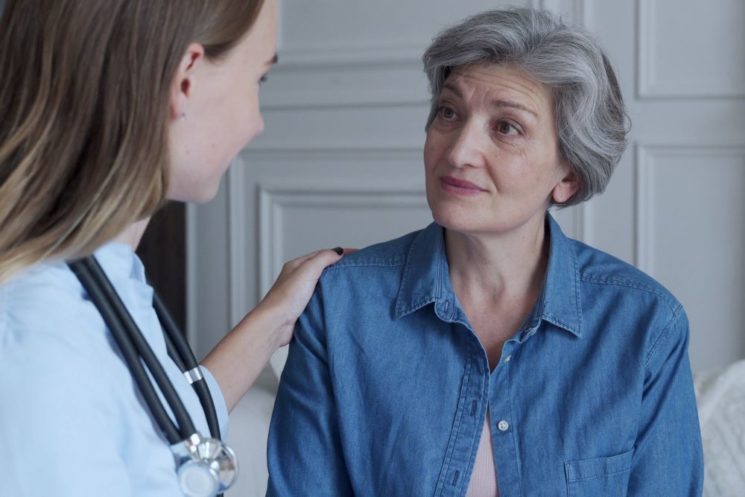
With summer on its way, it’s vitally important to stay sun-safe and be aware of the symptoms of skin cancer. We spoke to Dr Christina George, Consultant Dermatologist at Cromwell Hospital, to find out more about skin cancer warning signs to look out for.
Melanoma skin cancer
Melanoma skin cancer develops in skin cells called melanocytes, which are located deep in the epidermis (upper layer of skin). Melanocytes are responsible for producing melanin, a pigment that gives your skin its colour and helps protect it from the sun’s UV radiation.
Too much UV radiation can cause sunburn, which damages the genetic material (DNA) in your skin cells. If too much DNA damage occurs, you can develop melanoma skin cancer.
People with darker skin have more melanin, which means they are less likely to develop melanoma skin cancer. If you have fair skin that burns easily, or fair skin with red hair, you are at higher risk of developing melanoma.
Non-melanoma skin cancer
Non-melanoma skin cancer develops in skin cells called keratinocytes, which are located within the epidermis. They make up around 90% of all epidermal cells. Keratinocytes contribute to the skin’s barrier function and protect against environmental damage.
Most non-melanoma skin cancers develop due to prolonged sun exposure. Fortunately, they are often very treatable via surgery and don’t require any further intervention.
There are several types of non-melanoma skin cancer, including basal cell carcinoma and squamous cell carcinoma. Basal cells and squamous cells are both types of keratinocytes.
Basal cell carcinoma warning signs
Basal cell carcinoma (BCC) is a type of non-melanoma skin cancer. It’s the most common type of skin cancer, accounting for around 75% of non-melanoma cases.
BCC develops in the basal cells that are found deep within the epidermis and usually occurs in areas that are commonly exposed to the sun, such as the face, back, or lower legs. BCC doesn’t usually spread to other areas of the body.
Basal cell carcinoma symptoms include:
- A shiny, skin-coloured bump – it may also look pearly white or pink on fair skin, or brown or glossy black on dark skin. This bump may appear slightly translucent, meaning you can see through the upper layer.
- A pink or red-coloured growth that dips in the centre – it may also have a raised edge. The indentation in the centre may be crusted over or have visible blood vessels.
- A scar-like area of skin with no defined border – this may be white, yellow or waxy in colour.
- A flat, scaly patch of skin with a raised border – these can occasionally grow larger in size.
- An open sore that doesn’t heal – it may bleed, ooze or crust over. It may also heal and return after a short period of time.
- A pink or red-coloured patch of irritated skin – it may feel dry or scaly.
Squamous cell carcinoma warning signs
Squamous cell carcinoma (SCC) is a type of non-melanoma skin cancer. It’s less common than BCC, accounting for around 23% of non-melanoma cases.
SCC grows faster than BCC. Like BCC, they develop on areas commonly exposed to the sun, but may also develop on scars, ulcerated skin, or areas that have been burned in the past. Most SCCs are low risk and can be cured with surgery. However, they can on rare occasions metastasise to the lymph nodes and elsewhere in the body.
Squamous cell carcinoma symptoms include:
- A rough, scaly patch of skin – this can be an early symptom of SCC. This patch may look red on fair skin, or red, purple, brown or grey on dark skin. This patch may also crust or bleed.
- A sore that doesn’t heal, or heals and returns – it may bleed, crust, or persistent for several weeks.
- A round, raised growth – it may look like a wart, and crust or bleed on occasion.
- A cutaneous horn – informally known as an ‘animal horn’. This is a build-up of keratin that develops into a protruding growth on the skin.
SCC can also develop in other areas of the body, including inside the mouth, on the genitals, or beneath the nails. It may present as the following:
- In the mouth – A sore, or reddish-white patch.
- On the genitals – A raised, reddish area or wart-like sore.
- Beneath the nails – A red, brown, or black line beneath the nail. You may also develop a wart around the nail that doesn’t go away.
Melanoma warning signs
Melanomas present as moles on the skin. They may also develop from existing moles, which is why it’s important to be aware of any changes to your skin.
A checklist called ABCDE is a good starting point for assessing whether a mole may be melanoma:
- Asymmetry – most melanomas are asymmetrical in shape when compared to normal moles, which are usually symmetrical.
- Border – melanoma borders can be uneven, and may be scalloped or notched at the edges.
- Colour – melanomas often feature more than one colour, such as brown, black, or tan. Later stage melanomas may also have red, blue or white elements.
- Diameter – if a mole is getting larger, then it is important to have it checked.
- Evolving – if the mole continues to change in size or shape, or begins to crust or bleed, you should see your GP urgently.
Another test is to look for the ‘ugly duckling’. An ugly duckling is a mole that stands out in appearance from other, normal moles you may have – for example, a large, dark mole next to smaller, lighter moles.
What should you do if you notice potential signs of skin cancer?
It’s important to see your GP if you notice any changes in your skin that aren’t normal for you. The earlier skin cancer is caught, the easier it is to treat.
You should visit your GP if you experience any of the following symptoms for more than four weeks:
- A spot or sore that isn’t healing
- A spot or sore that’s painful, bleeds, crusts or is itchy
- An unexplained ulcer or broken-down area of skin
- A mole which is changing.
It’s also a good idea to take note of any existing moles you have, so that you can be alert to any changes in appearance. If you do notice a change in appearance, you should make an appointment with your GP as soon as possible.
Your GP will conduct a thorough examination of your skin and decide if you need a referral to a specialist or any diagnostic tests.
Is skin cancer itchy?
Yes, skin cancer may be itchy – however, itchy skin can also be a symptom of other, less serious conditions, such as inflammatory skin conditions or allergies.
Itchy skin could be a sign of skin cancer if it is accompanied by any of the symptoms mentioned above – such as a sore, a new skin growth, or a changing mole or skin lesion.
Is skin cancer deadly?
When caught early, skin cancer is highly treatable – with around 90% of non-melanoma cases successfully cured. Unlike other types of cancer, non-melanoma cancer has a low risk of spreading to other parts of the body.
Melanoma skin cancer is more aggressive and may require treatments in addition to surgery, such as immunotherapy, radiotherapy or chemotherapy. More advanced stages of melanoma, which have spread to other parts of the body, are harder to treat.
The outlook for skin cancer is usually better in women and those who are younger.
What causes skin cancer?
Most skin cancers are caused by exposure to the sun. In the UK, the sun is strongest from March to October, between the hours of 11am to 3pm.
You can reduce your risk of developing skin cancer by:
- Wearing SPF (ideally factor 30 or higher) and sun-protective clothing, such as hats and sunglasses
- Staying in the shade between 11am – 3pm, from March to October
- Avoiding the use of sunbeds.
You should take extra care in the sun if you are fair (especially if you have red hair) or have freckles and moles.
Why choose us for skin cancer care?
Cromwell Hospital is home to the Integrated Cancer Campus, our dedicated oncology department. We provide state-of-the-art diagnostics and treatments, as well as Europe’s most advanced radiotherapy centre.
Our team of world-class consultants and healthcare professionals provides expert multidisciplinary care to ensure our patients receive the best, most informed treatment plans possible.
About the consultant
Dr Christina George is a Consultant Dermatologist at Cromwell Hospital and the Imperial College Healthcare NHS Trust. She is experienced in all aspects of general dermatology including eczema, psoriasis, acne, rosacea, hair loss, excess sweating, and other dermatological conditions. She has expertise in skin cancer, including mole checks and skin surgery.



